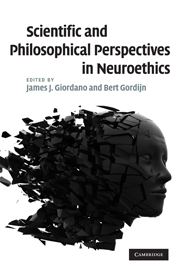Book contents
- Frontmatter
- Contents
- List of contributors
- Preface
- Acknowledgments
- Introduction
- 1 Developments in neuroscience
- 2 The origins of the modern concept of “neuroscience”
- 3 On the cusp
- 4 The mind-body issue
- 5 Personal identity and the nature of the self
- 6 Religious issues and the question of moral autonomy
- 7 Toward a cognitive neurobiology of the moral virtues
- 8 From a neurophilosophy of pain to a neuroethics of pain care
- 9 Transplantation and xenotransplantation
- 10 Neurogenetics and ethics
- 11 Neuroimaging
- 12 Can we read minds?
- 13 Possibilities, limits, and implications of brain-computer interfacing technologies
- 14 Neural engineering
- 15 Neurotechnology as a public good
- 16 Globalization: pluralist concerns and contexts
- 17 The human condition and strivings to flourish
- 18 The limits of neuro-talk
- Afterword
- Index
17 - The human condition and strivings to flourish
Published online by Cambridge University Press: 07 May 2010
- Frontmatter
- Contents
- List of contributors
- Preface
- Acknowledgments
- Introduction
- 1 Developments in neuroscience
- 2 The origins of the modern concept of “neuroscience”
- 3 On the cusp
- 4 The mind-body issue
- 5 Personal identity and the nature of the self
- 6 Religious issues and the question of moral autonomy
- 7 Toward a cognitive neurobiology of the moral virtues
- 8 From a neurophilosophy of pain to a neuroethics of pain care
- 9 Transplantation and xenotransplantation
- 10 Neurogenetics and ethics
- 11 Neuroimaging
- 12 Can we read minds?
- 13 Possibilities, limits, and implications of brain-computer interfacing technologies
- 14 Neural engineering
- 15 Neurotechnology as a public good
- 16 Globalization: pluralist concerns and contexts
- 17 The human condition and strivings to flourish
- 18 The limits of neuro-talk
- Afterword
- Index
Summary
THE HUMAN CONDITION: STRIVINGS TO FLOURISH
From a naturalistic perspective, humans, like any species, are defined both by their biology and by how this biology has established certain capabilities and limitations. In inhabiting diverse environments, the human species has been forced to confront such limitations (of form and function), and develop resourcefulness to survive in the niche(s) we occupy. And, as in other species, our survival is dependent, at least in part, upon the ability to maximally adapt to, and/or compensate for, both biological and environmental constraint(s). Yet, as evidenced by history, human beings are achievers. This is shown by the artifacts of our existence: social structures, tools, and implements that represent a striving to overcome our (self-apparent and/or self-declared) frailties and shortcomings. In short, humans show a trend toward not merely surviving, but flourishing (Gow 2002).
We propose that one neuroanthropologic view of human history could depict a species specific tendency toward enhancing our function, so as to occupy and subordinate increasingly broader niche(s) (Havercamp & Reiss 2003). Thus, human history is punctuated by our attempts to break the bonds of biological restrictions, and “be more than we are”; our relative dependence has been overcome by forming sociocultural cooperatives, our fears appeased by myth and assuaged by knowledge, and our weakness(es) compensated by intellect and invention. In this way, we can (and perhaps should) view our history as defined by its artifacts of biology, society, and machination (BioSoMa), in interaction.
- Type
- Chapter
- Information
- Scientific and Philosophical Perspectives in Neuroethics , pp. 343 - 354Publisher: Cambridge University PressPrint publication year: 2010
- 3
- Cited by

